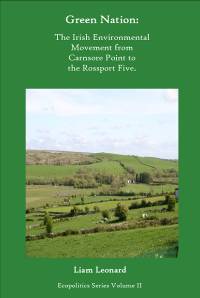|
Choice Publishing Book Store |
|
About the Author
Liam Leonard is a lecturer, freelance journalist and political activist and has published articles in academic journals and the Galway news media. His main interests include social and environmental campaigns, access and social inclusion, community development and local politics. Originally from Philadelphia in the United States, he has lived in London and Dublin but has resided in Galway for the last twelve years.
A lecturer in environmental politics and social movements in NUI Galway, he has also participated in the university's Access and Disabilities programmes. He was the first student diagnosed with dyslexia to be conferred with a Phd degree at NUI Galway, where he completed hid doctoral thesis on anti-incineration campaigns in Ireland. He has worked as a researcher for the Environmental Change Institute at NUIG, through the HEA's Social and Economic Research Group.
Dr Leonard is a founding editor of the Community and Environmental Journal, which aims to highlight interdisciplinary studies which focus on environment and community in the following fields: environmental and rural studies, social geography and social capital, social movements and civil society. He is also editor of Greenhouse Press, the Galway based social and environmental outlet for academic publications.
About the Book Ireland’s recent social history has been characterised by a series of environmentally based community challenges to multinational plants or infrastructural projects. These community responses are formulated from a populist rural sentiment or localised sense of place, that has been mobilised over the decades in which Ireland has undergone a dramatic transformation from a primarily agrarian and rural society to that of an industrialised economy obsessed by rapid growth and development.
Green Nation: The Irish Environmental Movement from Carnsore Point to the Rossport Five examines a number of the community-based campaigns that have come to make up a grassroots environmental movement in a changing Ireland. Starting with the “No Nukes” protests at Carnsore in the late 1970s and early 1980s, Green Nation traces the emergence a nascent ecopopulist movement that has witnessed a number of campaigns including anti-mining protests at Tynagh, Donegal and Croagh Patrick, anti-toxics activism in Cork, the heritage dispute at Mullaghmore, the campaigns against incineration in Galway, Meath and Cork, the anti-roads protests at the Glen of the Downs, Carrickmines and Tara/Skryne and the ongoing campaign of “Shell to Sea” in Mayo which gave rise to the incredible story of the “Rossport 5”, who were imprisoned for seeking justice for their community in North Mayo. Green Nation examines the mobilisation and framing processes undertaken in these disputes, locating them in the context of a wider rural identity that has shaped grassroots environmentalism in the Irish case.
Sample Excerpt
Chapter Twelve Anti-Roads Campaigns Glen of the Downs, Carrickmines and Tara/Skryne
Campaigns against the development of major motorways through environmentally sensitive areas have long been a feature of environmental movements across the developed world. This form of anti-infrastructural protest gained prevalence in the late 1980s and 1990s when Earth First began a series of protests around Europe. The most famous of these occurred at the Newbury by-pass and at Twyford Downs. The direct action of anti-roads protesters attracted a radical element to the environmental cause that were willing to take extreme measures, such as chaining and tunnelling, to prevent construction continuing. Earth First’s international mobilisation of local, single-issue anti-roads campaigners turned the NIMBYist nature of roads protests on its head. Where once local voices struggled to be heard Earth First’s experience in radical action provided a number of experienced and committed activists for an issue that could be ignited anywhere that roads developments were being undertaken. Borrowing the idea of a defence camp from the Greenham Common anti-nuclear protestors the anti-roads protests laid the foundations for the anti-globalisation protests of today, linking committed activists across Europe and North America in a common cause which combined opposition to growth economics with ecological concepts. The campaigners used internet technologies to link global groups around local issues and set the tone for eco-activism in subsequent years.
In time, the focus on the Irish state’s increased road building capacity has led to three main anti-roads protests. These occurred at the Glen of the Downs in County Wicklow, Carrickmines in County Dublin and at Tara/Hill of Skryne in County Meath. All three protests emerged at a time when the state was attempting to develop the commuter hub around Dublin city. The case of Tara/Hill of Skryne would lead to a heated debate about the manner in which heritage is dealt with in an age of rapid growth as the ancient site of Tara came under threat from the state’s Critical Infrastructural Bill. This Bill which was introduced in the wake of a series of environmental campaigns has been seen by many as an attempt to stymie such collective responses in the future.
|


|
Green Nation:
The Irish Environmental Movement from Carnsore Point to the Rossport Five.
By Liam Leonard
ISBN: 1-905451-11-3 978-1-905451-11-1 Price: €14.99 |